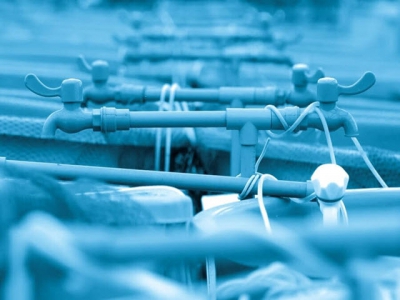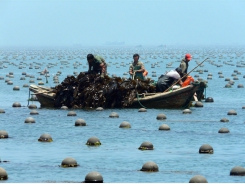A Guide to Recirculation Aquaculture - Part 3

Mechanical filtration
Mechanical filtration of the outlet water from the fish tanks has proven to be the only practical solution for removal of the organic waste products. Today almost all recirculated fish farms filter the outlet water from the tanks in a so called microscreen fitted with a filter cloth of typically 40 to 100 microns. The drumfilter is by far the most commonly used type of microscreen, and the design ensures the gentle removal of particles.
Function of the drumfilter:
1. Water to be filtered enters the drum.
2. The water is filtered through the drum’s filter elements. The difference in water level inside/outside the drum is the driving force for the filtration.
3. Solids are trapped on the filter elements and lifted to the backwash area by the rotation of the drum.
4. Water from rinse nozzles is sprayed from the outside of the filter elements. The rejected organic material is washed out of the filter elements into the sludge tray.
5. The sludge flows together with water by gravity out of the filter escaping the fish farm for external waste water treatment (see chapter 6).
Microscreen filtration has the following advantages:
• Reduction of the organic load of the biofilter.
• Making the water clearer as organic particles are removed from the water.
• Improving conditions for nitrification as the biofilter does not clog.
• Stabilising effect on the biofiltration processes.
Biological treatment
Not all the organic matter is removed in the mechanical filter, the finest particles will pass through together with dissolved compounds such as phosphate and nitrogen. Phosphate is an inert substance, with no toxic effect, but nitrogen in the form of free ammonia (NH3 ) is toxic, and needs to be transformed in the biofilter to harmless nitrate. The breakdown of organic matter and ammonia is a biological process carried out by bacteria in the biofilter. Heterotrophic bacteria oxidise the organic matter by consuming oxygen and producing carbon dioxide, ammonia and sludge. Nitrifying bacteria convert ammonia into nitrite and finally to nitrate.
The efficiency of biofiltration depends primarily on:
• The water temperature in the system.
• The pH level in the system.
To reach an acceptable nitrification rate, water temperatures should be kept within 10 to 35 °C (optimum around 30 °C) and pH levels between 7 and 8. The water temperature will most often depend on the species reared, and is as such not adjusted to reach the most optimal nitrification rate, but to give optimal levels for fish growth. Regulation of pH in relation to biofilter efficiency is however important as lower pH level reduces the efficiency of the biofilter. The pH should therefore be kept above 7 in order to reach a high rate of bacterial nitrifying. On the other hand, increasing pH will result in an increasing amount of free ammonia (NH3 ), which will enhance the toxic effect. The aim is therefore to find the balance between these two opposite aims of adjusting the pH. A recommended adjustment point is between pH 7.0 and pH 7.5.
Two major factors affect the pH in the water recirculation system:
• The production of CO2 from the fish and from the biological activity of the biofilter.
• The acid produced from the nitrification process.
Result of nitrification:
NH4 (ammonium) + 1.5 O2 → NO2 (nitrite) + H2O + 2H+ + 2e
NO2 (nitrite) + 0.5 O2 → NO3 (nitrate) + e
___________________________________
NH4 + 2 O2 ↔ NO3 + H2O + 2H+
CO2 is removed by aeration of the water, whereby degassing takes place. This process can be accomplished in several ways as described later in this chapter.
The nitrifying process produces acid (H+ ) and the pH level falls. In order to stabilize the pH, a base must be added. For this purpose lime or sodium hydroxide (NaOH) or another base needs to be added to the water.
Fish excretes a mixture of ammonia and ammonium (Total Ammonia Nitrate (TAN) = ammonium (NH4 + ) + ammonia (NH3 )) where ammonia constitutes the main part of the excretion. The amount of ammonia in the water depends however on the pH level as can be seen in figure 2.8, which shows the equilibrium between ammonia (NH3 ) and ammonium (NH4 + ).

Figure 2.8 The equilibrium between ammonia (NH3 ) and ammonium (NH4 + ) at 20 °C. The toxic ammonia is absent at pH below 7, but rises fast as pH is increased.

Figure 2.9 The relation between measured pH and the amount of TAN available for breakdown in the biofilter, based upon a toxic ammonia concentration of 0.02 mg/L.
In general, ammonia is toxic to fish at levels above 0.02 mg/L. Figure 2.9 shows the maximum concentration of TAN to be allowed at different pH levels if a level below 0.02 mg/L of ammonia is to be ensured. The lower pH levels minimises the risk of exceeding this toxic ammonia limit of 0.02 mg/L, but the fish farmer is recommended to reach a level of minimum pH 7 in order to reach a higher biofilter efficiency as explained earlier. Unfortunately, the total concentration of TAN to be allowed is thereby significantly reduced as can be seen in figure 2.9. Thus there are two opposite working vectors of the pH that the fish farmer has to take into consideration when tuning his biofilter.
Nitrite (NO2 - ) is formed at the intermediate step in the nitrification process, and is toxic to fish at levels above 2.0 mg/L. If fish in a recirculation system are gasping for air, although the oxygen concentration is fine, a high nitrite concentration may be the cause. At high concentrations, nitrite is transported over the gills into the fish blood, where it obstructs the oxygen uptake. By adding salt to the water, reaching as little as 0.3 ‰, the uptake of nitrite is inhibited.
Nitrate (NO3 - ) is the end-product of the nitrification process, and although it is considered harmless, high levels (above 100 mg/L) seem to have a negative impact on growth and feed conversion. If the exchange of new water in the system is kept very low, nitrate will accumulate, and unacceptable levels will be reached. One way to avoid the accumulation is to increase the exchange of new water, whereby the high concentration is diluted to a lower and trouble-free level.
On the other hand, the whole idea of recirculation is saving water, and in some instances water saving is a major goal. Under such circumstances, nitrate concentrations can be reduced by de-nitrification. Under normal conditions, a water consumption of more than 300 litres per kg feed used is sufficient to dilute the nitrate concentration. Using less water than 300 litres per kg feed makes the use of denitrification worth considering.
The most predominant denitrifying bacteria is called Pseudomonas. This is an anaerobic (no oxygen) process reducing nitrate to atmospheric nitrogen. In fact, this process removes nitrogen from the water into the atmosphere, whereby the load of nitrogen into the surrounding environment is reduced. The process requires an organic source (carbon), for example wood alcohol (methanol) that can be added to a denitrification chamber. In practical terms 2.5 kg of methanol is needed for each kg nitrate (NO3 -N) denitrified. Most often the denitrification chamber is fitted with biofilter media designed with a residence time of 2-4 hours. The flow must be controlled to keep outlet oxygen concentration at app. 1 mg/L. If oxygen is completely depleted extensive production of hydrogen sulphide (H2 S) will take place, which is extremely toxic to fish and also bad smelling (rotten egg). Resulting production of sludge is quite high, and the unit has to be back-washed, typically once a week.

Figure 2.10 Moving bed media on left and fixed bed media on right.
Biofilters are typically constructed using plastic media giving a high surface area per m3 of biofilter. The bacteria will grow as a thin film on the media thereby occupying an extremely large surface area. The aim of a well-designed biofilter is to reach as high a surface area as possible per m3 without packing the biofilter so tight that it will get clogged with organic matter under operation. It is therefore important to have a high percentage of free space for the water to pass through and to have a good overall flow through the biofilter together with a sufficient back-wash procedure. Such back-wash procedures must be carried out at sufficient intervals once a week or month depending on the load on the filter. Compressed air is used to create turbulence in the filter whereby organic matter is ripped off. The biofilter is shunted while the washing procedure takes place, and the dirty water in the filter is drained off and discharged before the biofilter is connected to the system again.
Biofilters used in recirculation systems can be designed as fixed bed filters or moving bed filters. All biofilters used in recirculation today work as submerged units under water. In the fixed bed filter, the plastic media is fixed and not moving. The water runs through the media as a laminar flow to make contact with the bacterial film. In the moving bed filter, the plastic media is moving around in the water inside the biofilter by a current created by pumping in air. Because of the constant movement of the media, moving bed filters can be packed harder than fixed bed filters thus reaching a higher turnover rate per m3 of biofilter. There is however no significant difference in the turnover rate calculated per m2 (filter surface area) as the efficiency of the bacterial film in either of the two types of filter is more or less the same. In the fixed bed filter, however, fine organic particles are also removed as these substances adhere to the bacterial film. The fixed bed filter will therefore act also as a fine mechanical filtration unit removing microscopic organic material and leaving the water very clear. The moving bed filter will not have the same effect as the constant turbulence of water will make any adhesion impossible.


Figure 2.11 Moving bed (top) and fixed bed biofilters (bottom).
Both filter systems can be used in the same system, or they can be combined; using the moving bed to save space and the fixed bed to benefit from the adhering effect. There are several solutions for the final design of biofilter systems depending on farm size, species to be cultured, sizes of fish, etc.
Có thể bạn quan tâm
Phần mềm

Phối trộn thức ăn chăn nuôi

Pha dung dịch thủy canh

Định mức cho tôm ăn

Phối trộn phân bón NPK

Xác định tỷ lệ tôm sống

Chuyển đổi đơn vị phân bón

Xác định công suất sục khí

Chuyển đổi đơn vị tôm

Tính diện tích nhà kính

Tính thể tích ao hồ



 A Guide to Recirculation Aquaculture - Part 4
A Guide to Recirculation Aquaculture - Part 4  A Guide to Recirculation Aquaculture - Part 2
A Guide to Recirculation Aquaculture - Part 2